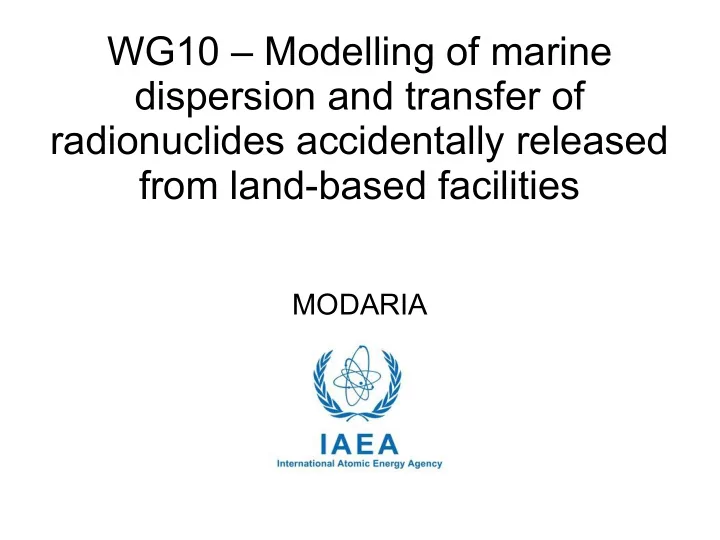

WG10 – Modelling of marine dispersion and transfer of radionuclides accidentally released from land-based facilities MODARIA
Scenarios 1) Fukushima releases in the Pacific Ocean ● Intercomparison of hydrodynamic submodels ● First simple dispersion exercise ● Generation of input data for WG8 biota dynamic modelling exercise 2) The Baltic Sea: modelling Chernobyl fallout ● Scenario description potentially finished: distributed on June 6 th , 2013 ● First modelling results to be discussed
Fukushima: several models already working Institute Scale Circulation Model type KAERI Regional, NCOM, Lagrangian global JCOPE2 JAEA Local, Kyoto Lagrangian regional, University global Univ. Tolouse Regional NCOM (bc) Eulerian Univ. Seville local JCOPE2, Eulerian HYCOM IMMSP regional HYCOM (bc) Eulerian Ukraine
Model harmonization An ocean transport model consists of two sub-models Hydrodynamic model • Dispersion model (advection, diffusion, sediments...) • Which is the main responsible of differences in output? Run models with the same forcing to evaluate differences Compare: -Time series of currents at given locations -Current fields at given times Next: -Source term -Atmospheric deposition
Current field examples, April 30th (sea surface) NCOM JAEA JCOPE2
Time series of currents
SST data for the first week of April IMMSP (Ukraine) has made a quantitative comparison of modelled SST fields It will be discussed during this meeting
Simple dispersion exercise Arbitrary constant release No atmospheric deposition Dissolved radionuclide Time frame: March 26 to May 30 Each team uses its own hydrodynamic data/calculations Results: -time series of radionuclide concentrations in surface water -map of surface radionuclide concentrations
Example of results: What happens if all models use the same hydrodynamics?: phase 2 of the exercise
Baltic Sea ● Complex scenario – Hydrodynamics (salinity gradients, ice, etc) – Multiple radionuclide sources, although Chernobyl dominates – Remobilisation of radionuclides from sediments ● Proposed exercise – 5 year of calculation after Chernobyl pulse – Provide: ● Time series of 137-Cs concentrations in water and sediments at specific sites ● Time series of 137-Cs inventories in water and sediments ● Concentration maps (water/sediment) at the end of simulation ● Objective: test output sensitivity to water/sediment interaction descriptions
Chernobyl fallout resulting 137-Cs concentrations in surface water Two exercises: 1) sediments initially clean 2) background concentrations in sediments considered
137-Cs inventories in the Baltic Sea: water and sediments
Recommend
More recommend